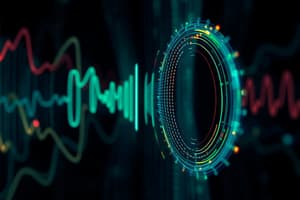Podcast
Questions and Answers
What do formants in vowel sounds primarily reflect?
What do formants in vowel sounds primarily reflect?
- The frequency of the sound wave
- The shape information from the articulators (correct)
- The amplitude modulation of sound
- The duration of the sound wave
What does the auditory system mainly process within?
What does the auditory system mainly process within?
- Local frequency details
- Narrow frequency channels (correct)
- Broad ranges of sound
- Wide frequency channels
Where does tonotopic processing occur in the auditory pathway?
Where does tonotopic processing occur in the auditory pathway?
- Only in the brainstem
- Only in the cochlea
- From cochlea to the cortex (correct)
- Exclusively in the cortex
In which area of the brain is across-frequency integration likely to occur?
In which area of the brain is across-frequency integration likely to occur?
What is a function associated with the planum temporale?
What is a function associated with the planum temporale?
What role does the superior temporal sulcus play in the auditory system?
What role does the superior temporal sulcus play in the auditory system?
What type of stimuli is the planum temporale NOT involved in processing?
What type of stimuli is the planum temporale NOT involved in processing?
Which characteristic is NOT associated with the functions of the planum temporale?
Which characteristic is NOT associated with the functions of the planum temporale?
What type of auditory information does the planum temporale integrate?
What type of auditory information does the planum temporale integrate?
What type of modality is primarily analyzed by the superior temporal sulcus?
What type of modality is primarily analyzed by the superior temporal sulcus?
How many bands did Fletcher divide the frequency spectrum into?
How many bands did Fletcher divide the frequency spectrum into?
How many audible octaves are typically required for speech sounds?
How many audible octaves are typically required for speech sounds?
What is the distance between the features required for speech sounds in terms of the basilar membrane?
What is the distance between the features required for speech sounds in terms of the basilar membrane?
How many features are needed per speech sound for optimal understanding?
How many features are needed per speech sound for optimal understanding?
What does intelligibility in speech depend on?
What does intelligibility in speech depend on?
What is the primary basis for diagnosing speech limitations?
What is the primary basis for diagnosing speech limitations?
Which area of the auditory system is primarily affected when discussing pitch distinctions in languages?
Which area of the auditory system is primarily affected when discussing pitch distinctions in languages?
How many languages are spoken around the world, highlighting linguistic diversity?
How many languages are spoken around the world, highlighting linguistic diversity?
Which structure within the auditory system is involved in the mechanical process of hearing?
Which structure within the auditory system is involved in the mechanical process of hearing?
What method can be used alongside pure tone tests to identify speech understanding problems?
What method can be used alongside pure tone tests to identify speech understanding problems?
What is the primary concern associated with hearing loss?
What is the primary concern associated with hearing loss?
Which of the following does NOT represent an impact of hearing impairments?
Which of the following does NOT represent an impact of hearing impairments?
What percentage of the final grade do the Case-Study Quizzes contribute?
What percentage of the final grade do the Case-Study Quizzes contribute?
How is the class structured in terms of group work?
How is the class structured in terms of group work?
Which of the following is NOT part of the topics covered in audiological diagnosis?
Which of the following is NOT part of the topics covered in audiological diagnosis?
What method is used for evaluating the social impacts of hearing loss?
What method is used for evaluating the social impacts of hearing loss?
What is required from the group trainers after the lab session?
What is required from the group trainers after the lab session?
Which examination covers material from both behavioral and physiologic measures?
Which examination covers material from both behavioral and physiologic measures?
What is the primary function of the auditory system's precise channel information?
What is the primary function of the auditory system's precise channel information?
Which of the following correctly distinguishes between coarse detail and fine detail?
Which of the following correctly distinguishes between coarse detail and fine detail?
Why might it be said that 'the brain is for speech and the ear is for music'?
Why might it be said that 'the brain is for speech and the ear is for music'?
What does the term 'dichotic' refer to in the context of auditory perception?
What does the term 'dichotic' refer to in the context of auditory perception?
What might occur when details are missing in a noisy environment?
What might occur when details are missing in a noisy environment?
What does the concept of 'Auditory Chimeras' explore?
What does the concept of 'Auditory Chimeras' explore?
How does the auditory system help in challenging listening environments?
How does the auditory system help in challenging listening environments?
What aspect of sound processing is emphasized to differentiate between speech and music?
What aspect of sound processing is emphasized to differentiate between speech and music?
What is a common symptom observed in a patient with asymmetric hearing loss?
What is a common symptom observed in a patient with asymmetric hearing loss?
In a case where a young female athlete has suddenly poorer hearing in one ear after trauma, what assessment might be abnormal?
In a case where a young female athlete has suddenly poorer hearing in one ear after trauma, what assessment might be abnormal?
What type of assessment would likely show elevated values for a patient with chronic otitis media?
What type of assessment would likely show elevated values for a patient with chronic otitis media?
What might be a significant finding in a child showing difficulty with competing speech despite normal word discrimination scores?
What might be a significant finding in a child showing difficulty with competing speech despite normal word discrimination scores?
Which of the following conditions is indicated by prolonged I-V intervals in ABR on one side?
Which of the following conditions is indicated by prolonged I-V intervals in ABR on one side?
What does the presence of otoacoustic emissions in a patient suggest in relation to their auditory condition?
What does the presence of otoacoustic emissions in a patient suggest in relation to their auditory condition?
In a case of unilateral right hearing loss with a notch at 4 kHz, what assessment finding is likely to be present?
In a case of unilateral right hearing loss with a notch at 4 kHz, what assessment finding is likely to be present?
Which assessment type is used to evaluate the function of the middle ear and its ability to transmit sound?
Which assessment type is used to evaluate the function of the middle ear and its ability to transmit sound?
Flashcards
Presbyacusis
Presbyacusis
A hearing loss that primarily affects the ability to hear high-pitched sounds.
Activity Limitation
Activity Limitation
The difficulty in communication due to hearing loss, which can impact a person's ability to participate in activities.
Participation Restriction
Participation Restriction
The negative impact of hearing loss on a person's overall life, affecting their ability to engage and participate in daily life.
Audiological Diagnosis
Audiological Diagnosis
Signup and view all the flashcards
Immittance Battery
Immittance Battery
Signup and view all the flashcards
Otoacoustic Emissions
Otoacoustic Emissions
Signup and view all the flashcards
Paediatric Assessment
Paediatric Assessment
Signup and view all the flashcards
Electrophysiologic Measures
Electrophysiologic Measures
Signup and view all the flashcards
Fletcher's Band
Fletcher's Band
Signup and view all the flashcards
Speech Feature
Speech Feature
Signup and view all the flashcards
Octave in Hearing
Octave in Hearing
Signup and view all the flashcards
Speech Information Distribution
Speech Information Distribution
Signup and view all the flashcards
Audiogram (Purpose)
Audiogram (Purpose)
Signup and view all the flashcards
Dichotic Listening
Dichotic Listening
Signup and view all the flashcards
Lip-Reading
Lip-Reading
Signup and view all the flashcards
Speech Processing In The Brain
Speech Processing In The Brain
Signup and view all the flashcards
The Detail Puzzle
The Detail Puzzle
Signup and view all the flashcards
Auditory Chimeras
Auditory Chimeras
Signup and view all the flashcards
Coarse Detail (Envelope)
Coarse Detail (Envelope)
Signup and view all the flashcards
Fine Detail (Fine Structure)
Fine Detail (Fine Structure)
Signup and view all the flashcards
The Brain Is for Speech, The Ear Is for Music
The Brain Is for Speech, The Ear Is for Music
Signup and view all the flashcards
Outer Ear Effects
Outer Ear Effects
Signup and view all the flashcards
Role of Middle Ear
Role of Middle Ear
Signup and view all the flashcards
MAP and MAF
MAP and MAF
Signup and view all the flashcards
Human Hearing
Human Hearing
Signup and view all the flashcards
In the Cochlea
In the Cochlea
Signup and view all the flashcards
What creates the 'shape' of vowel sounds?
What creates the 'shape' of vowel sounds?
Signup and view all the flashcards
Why are wide frequency patterns important for hearing?
Why are wide frequency patterns important for hearing?
Signup and view all the flashcards
What is tonotopic processing?
What is tonotopic processing?
Signup and view all the flashcards
Where does across-frequency processing happen in the brain?
Where does across-frequency processing happen in the brain?
Signup and view all the flashcards
Which brain area integrates across-frequency information?
Which brain area integrates across-frequency information?
Signup and view all the flashcards
What is spectral motion?
What is spectral motion?
Signup and view all the flashcards
How does the planum temporale process speech?
How does the planum temporale process speech?
Signup and view all the flashcards
What is the role of the superior temporal sulcus?
What is the role of the superior temporal sulcus?
Signup and view all the flashcards
Why is across-frequency processing important for hearing?
Why is across-frequency processing important for hearing?
Signup and view all the flashcards
What makes the planum temporale crucial for auditory processing?
What makes the planum temporale crucial for auditory processing?
Signup and view all the flashcards
Acoustic Immittance
Acoustic Immittance
Signup and view all the flashcards
Electrophysiology
Electrophysiology
Signup and view all the flashcards
Auditory Brainstem Response (ABR)
Auditory Brainstem Response (ABR)
Signup and view all the flashcards
Distortion Product Otoacoustic Emissions (DPOAE)
Distortion Product Otoacoustic Emissions (DPOAE)
Signup and view all the flashcards
Audiometry
Audiometry
Signup and view all the flashcards
Speech Audiometry
Speech Audiometry
Signup and view all the flashcards
Study Notes
Hearing Measurement Lecture 1
- The lecture covers audiometric measurement for Speech Language Pathologists (SLPs) and Audiologists (AUDs)
- The goals of the course are to provide a foundation for understanding audiometric results for SLP students and a basis for more advanced training for AUD students
- An understanding of basic principles and techniques will be developed, including the basic tests, how to perform them, the information each test provides, and how to interpret the information.
- Diagnoses can be physiological or rehabilitative
- Physiological diagnoses deal with what may be wrong, such as conditions that might be better treated with surgery than a hearing aid.
- Rehabilitative diagnosis involves strategies for helping people overcome obstacles and limitations
- Assessment and rehabilitation of receptive communication are the primary focus of the course.
- The course differentiates between physiological and rehabilitative diagnosis.
Types of Diagnosis
-
Physiological diagnosis focuses on the body level (structure and function).
-
Aspects of physiological diagnosis include normal/abnormal status, site of lesion, cause, and prognosis.
-
Rehabilitative diagnosis concentrates on the person level (activities and participation).
-
Considerations include if there is a problem or not and the person's capacity to perform daily tasks, along with speech understanding issues and strategies for mitigating impairment and overcoming limitations.
Physiologic Perspective
- Different types of hearing loss call for different treatment options
Rehabilitative Perspective
- Hearing loss is often a normal part of aging (presbycusis)
- Hearing loss is not always a medical concern.
- Hearing impairments often affect communication and negatively impact daily life.
Audiological Diagnosis
- Audiological diagnosis involves examining body and person factors.
Making Sense of Audiological Data
- The course covers several aspects of testing including audiograms, tympanograms, and other measures to asses hearing issues.
- Various graphs and charts are used to show data
Topics
- Pure-tone air and bone-conduction measures are covered
- Audiometric masking, speech testing, issues like pseudohypoacusis, hyperacusis, and tinnitus are also discussed
- Hearing loss prevention methods are detailed in the lecture
- Topics include the immittance battery, otoacoustic emissions, paediatric assessments, electrophysiological measures, and hearing aids and implants.
Course Format
- Lectures and integrated lab demonstrations are included, as are readings with a workbook, case quizzes, hands-on lab experiences, a midterm examination, and in-class tests.
Grading
- The course utilizes case study quizzes, lab reports, and a midterm exam to assess student learning.
- The specifics of quiz and exam weights are outlined.
Case Quizzes
- The course includes short case study quizzes (~5-10 minutes) administered in class.
- Each quiz contains a clinical audiogram and 3 multiple-choice questions that assess understanding of the loss, possible cause, and appropriate follow-up.
Lab Structure
- There are 9 groups of 4 and 1 of 3. Each group receives assignments and is responsible for issues
- Group assignments will be made next week
- A member of each group leads the session (TA led)
Tests
- A midterm exam covers the first half of the course material (including behavioral measures).
- The second half of the course covers physiology, hearing aids, and implants; three specific in-class tests assess learning in that subject matter.
- In-class tests are structured to cover these topics.
- A final exam is not included.
Activity Limitations in Audiology
- The primary limitation is trouble hearing or understanding speech, usually due to more than just the loudness of the speech itself.
Loss of Tuning on Basilar Membrane
- The energy flow characteristics in the basilar membrane are crucial in maintaining auditory processing.
Details Don't Seem to Matter For Speech
- Correct letter order and sequence is not the only aspect of understanding language. The key is the initial and final words to form well-formed words
Information in Speech: Features
- Sounds like /b/, /a/, /d/, and /i/ are measured and characterized based on glottal pulses
But what is the "real" feature? Formants?
- Formants, isolated from speech, are sufficient for speech understanding. The important structures in spoken language are the sound shapes
What is the “real” feature? Another Look at Formants
- Speech Recognition in studies using primarily formants was successful
Across-Frequency Shape (Formants)
- This topic outlines the shapes across frequency, covering the critical components of speech processing (formants).
Information in Speech: the Beginning
- Initial studies on speech emphasized the importance of the wide range of frequencies in speech recognition
1/3rd Octave-Band Importance Function (ANSI S3.5)
- The specific frequency bands and their significance with regards to human hearing measurement are outlined.
Information in Speech
- The lecture reviews speech characteristics
Importance of 0-800 Hz and other frequency bands
- Studies cover the frequency ranges and their significance
General Finding and conclusions
How Does This Relate to Hearing Measurement?
- Fletcher's work on essential frequencies and their relationship to 1 mm on the basilar membrane
- Features and octaves for speech sounds.
- Audiograms and their relationships to certain speech sounds and features.
The Audiogram was Designed for This
- Audiograms are standard tools for measuring hearing
Quick Summary
- Speech perception requires processing a wide range of frequencies
- Comparison across different frequencies is the essential part of speech understanding
Formants vs. Harmonics
- Formants are crucial features in understanding speech
Mouth Movements
- Mouth movements and characteristics in speech processing
Wide Patterns, Not Local Frequency Details
- The auditory system processes sounds in narrow frequency channels, with specific differences being important
Tonotopicity persists from cochlea to cortex (PAC)
- Tonotopicity persists from the cochlea to the cortex with tonal stimulation (in chinchillas).
An simple auditory processing schematic
- Detailed schematic relating auditory processing to anatomical structures in the auditory pathways
Across frequency processing must be above the cortex! (PAC)
- Across-frequency processing crucial outside the cortex (PAC)
Across-Frequency Integration – Association Cortex
- The planum temporale (association cortex) plays a role across-frequency integration
planum temporale processes across-frequency changes
- The planum temporale processes across-frequency changes (like duration, harmonic complexes, and the like) across tasks requiring this integration.
Speech sounds are processed in the brain, not the ear
- Speech sounds are processed in the brain based on formant patterns in the frequency spectrum.
The Detail Puzzle
- The ear has precise within-channel information and temporal resolution for challenging hearing environments and sound discrimination
Auditory Chimeras (Smith et al., Nature, 2002)
- Visual depictions of hybrid species illustrate the importance of speech sound processing
Shape Across-Frequency versus Details
- Illustrative figures illustrating speech and music processing (using chimera/hybrid examples)
The Brain is for Speech The Ear is for Music
- Summarizes the respective roles of the brain and ear in speech and music processing.
Seems Like a Lot of Trouble just for Music!
- Funny, whimsical statement about music complexity
What happens in noise when the details are missing?
- There is a breakdown/failure in sound processing
And when the details are present...
- Results in the proper output and breakdown in noise processing.
Sound is All Around Us
- A general observation regarding sounds and their prevalence in the environment.
Details are required for disentangling and tracking voices
- Auditory scene analysis (using examples of unraveling audio information)
The Healthy Ear
- Overview of the healthy ear characteristics
Consequences of Hearing Loss
- Hearing loss impacts fine details encoding
- OHC damage affects frequency tuning and precision
Disentangling/Tracking Sounds is Called “Scene Analysis"
- Hearing loss affects both audibility and scene analysis.
Understanding Speech Perception
- Speech contains "shape" information, crucial for understanding and is best analyzed by audibility across frequencies.
Understanding Speech Perception
- Fine details are essential for hearing in noisy situations, including tracking and distinguishing sounds.
Going beyond English...
- Linguistic diversity influences hearing studies, given that there are multiple languages that use features not common in English
Diagnosis of Speech Limitations (overview)
- Speech understanding limitations are often primarily due to audibility.
Part Two: Physiologic Diagnosis (overview)
- Audiologist points of entry and characteristics regarding health
Diagnosis of Impairment - The Non-Impaired System
- The use of audiograms and other tests to assess the non-impaired system.
Understanding Structure and Function
- Overview of factors that affect auditory function.
The Outer Ear
- The specifics of the outer ear, structures, and functions are described.
Outer Ear Effects
- The outer ear affects the hearing response from the environment.
Role o Middle Ear
- The role of the middle ear
MAP and MAF (overview)
- MAP and MAF (in dB SPL) across different frequencies are detailed.
Human Hearing and detailed figures
- Illustrates characteristics and differences/variations between various sounds and noise.
In the Cochlea
- Describes the physical and structural components of the cochlea
The Travelling Wave
- The travelling wave characteristics, depicting how the sound waves move through the cochlea.
Basilar Membrane Pulled Upwards
- Basic drawing/diagram of BM pulling upwards
Tip Links Open Ion Channels
- Structures associated with hair cells
Action Potential is Generated
- Describes how action potentials are generated in auditory structures
How Frequency Selective?
- A method by which frequency is tested (measured)
Role of Outer Hair Cells
- Specific energy functions by outer hair cells
Neural Tuning Curves
- The curves associated with neural responses across frequencies
Cochlear Nerve Responses to Pure Tones
- Response data for cochlear nerves related to frequency.
Introduction to Diagnosis
- Overview of introduction to diagnosis.
Diagnosis is Detective Work
- Examples of diagnostic processes and information/observations gathered
Types of Assessment Overview
- General overview related to types of assessment.
Assessment Types
- Specific types of assessments.
Studying That Suits You
Use AI to generate personalized quizzes and flashcards to suit your learning preferences.




